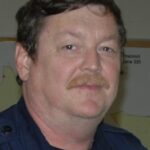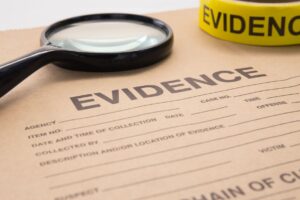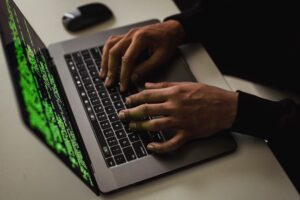- d/FEAT, LLC is now part of BWI
What’s New
BWI Investigation Helps Lead to a Not-Guilty Verdict in a 2017 Homicide Case
In September 2017, a police detective took a mere 18 minutes to decide that Trevor Wells had committed premeditated first-degree murder during a violent struggle in his La Vergne home.
It took preeminent Crime Scene Analyst Johnny Lawrence of Berry-Waltz Investigations (BWI) four days to reconstruct the crime scene and determine Trevor had told the truth the entire time – he’d acted in self-defense.
A Rutherford County jury agreed in March 2022. Trevor Wells was found not guilty of first-degree murder in a case that Johnny Lawrence and defense attorney Joshua T. Crain say wound up in court because of a police officer’s rush to judgment.
“Our client gave seven different statements and all of them were consistent,” Johnny explained. “The detective hadn’t had many cases before. He based his probable cause on his theory rather than facts.
“When he first pulled up to the scene, the detective started an audio recording,” Johnny said. “What I found is that 18 minutes after arriving on scene – before he has any documentation of the victim’s injuries or even talked to our client – he says, ‘this is premeditated.’ It’s what we called cognitive bias, where you start forming opinions and try to make the evidence at the scene fit your theory.”

Crime Scene Analyst Johnny Lawrence of BWI conducted a defense investigation that helped lead to a recent not-guilty verdict in a first-degree murder trial.
Johnny Lawrence gained his crime scene expertise by being involved in nearly 1,000 homicide investigations in addition to other types of death investigations since 1982. He is a former Nashville Metropolitan Police Department detective. Johnny has taken extensive training in crime scene investigations and bloodstain patterns during his 39-year career and now provides similar training to lawyers and other independent investigators.
The incident Johnny investigated occurred when Trevor Wells tried to wake a man asleep in Trevor’s home and kick him out of the house. The man, Brandon Marable, was an acquaintance of Trevor’s then-wife. Trevor was concerned Brandon was using methamphetamines and that no one else was at home with Trevor’s children. When Trevor woke Brandon by kicking the chair he was sleeping in, Brandon attacked Trevor. A struggle ensued, mostly in Trevor’s kitchen, and Trevor shot Brandon three times.
Defense lawyer Joshua T. Crain said Johnny’s investigation and trial testimony helped lay the groundwork that Trevor’s account was credible.
“The work Johnny was able to do was twofold: One, he was able to point out things that the investigator for the police department had either missed or done wrong. Two, he was able to recreate the scene, so we had a better idea of whether or not our client’s version of events was even plausible,” Joshua said.
There was a bullet strike mark on the linoleum kitchen floor from where a bullet exited the victim’s body and hit the floor. Police photographed and cut out that flooring section – a key piece of evidence – but didn’t retain it or run dowel rods into it to determine the bullet trajectory. This would have been important, the defense attorney said, for police to determine whether Trevor’s version of events was accurate or inaccurate.
Johnny’s examination of the crime scene photographs showed a bevel in the flooring that helped him determine directionality of the bullet. He testified that based on the way the linoleum beveled when the bullet hit it, he could determine directionality of the bullet, which was fired from a high-caliber, small gun – a .40-caliber Walther.
A firearms expert testified that Trevor’s account was plausible. He explained the .40-caliber Walther has a high muzzle velocity; the recoil on the gun caused the bullets to “climb” as the gun was fired. That matched the bullet trajectories on the floor and the bullet pattern in the victim’s body. A doctor also testified about how methamphetamines can affect someone’s behavior.
“Johnny was able to recreate the scene and recreate the investigation that should have been done,” defense attorney Joshua Crain said.
Johnny’s expertise worked “in concert with firearms expert and, ultimately, a medical doctor who testified about the irrational, aggressive behavior of a person who is highly intoxicated on methamphetamines, which is what the victim was,” the defense attorney said.
Joshua said Trevor is greatly relieved. “He had this hanging over his head since 2017. He faced life in prison with no chance of parole; that’s how close he came.”
Trevor’s family retained Joshua Crain, and he was able to apply for and receive court funding to hire Berry-Waltz Investigations.
“I have been doing criminal defense work for 17 years, and this case is a prime example of why I believe competent criminal defense attorneys should always hire qualified, high-caliber defense investigators and defense experts such as Berry-Waltz Investigations,” Joshua said.
BWI Can Help Your Clients
For more information about how BWI can assist in the defense of your clients, please call us at (615) 646-0860 or message us through this contact form.
Berry-Waltz Investigations (BWI) Expands Its Offerings for Clients, Now Provides Paralegal Services
Paralegals Help Lawyers Make the Best Use of Their Time
Berry-Waltz Investigations (BWI) is pleased to announce we have a certified paralegal on staff to assist our clients.
Our paralegal is a familiar face – BWI Private Investigator Mallory Whitworth, whose past expertise as a legal assistant led her to further her education and earn her official paralegal certification. She also has a bachelor’s degree in criminal justice.
Mallory is a BWI fact investigator who previously worked as a legal assistant for a prominent criminal defense attorney and as a Deputy Clerk in Giles County. Her background gives her a unique perspective and “boots-on-the-ground” proficiency as both a fact investigator and paralegal.
Why Hire a Paralegal?
As a paralegal, Mallory will help BWI clients conduct legal research, draft motions and other court pleadings, interview witnesses, organize and quality-control court files, file legal paperwork, assist during trials, and/or conduct trial preparation.
BWI is offering paralegal services to further assist criminal defense attorney clients defending clients in federal court. In federal cases, a large group of federal defendants is sometimes charged in what’s known as a “mega-case.” Mega-cases have incredible amounts of evidence and discovery – sometimes well over 7 million to 10 million documents. Mallory will assist with document management, help implement the attorney’s discovery plan, and draft responses to documents.

BWI Private Investigator Mallory Whitworth is now also a certified paralegal. (Photo by Guy Schafer.)
“During discovery, I can help them by organizing documents, making sure they’ve received everything, identifying any missing documents, and determining the status of documents they’re still waiting for,” Mallory says. “My work makes it easier for the attorneys to prioritize the documents and focus on building their case.”
Mallory’s paralegal expertise also applies equally to civil cases. She will assist with legal research and help streamline the discovery process through document management and quality control.
In the meantime, Mallory can also help BWI clients as a fact investigator by locating and interviewing witnesses, performing background checks on witnesses involved in a case, developing additional parties to a case, and preparing reports, among other responsibilities.
“We really can do it all at BWI,” Mallory says. “We can assist their case from the time of initial filing through trial.”
Obtain More Information
For more information, please call BWI at (615) 646-0860 or message us through this contact form.
Vital to a Strong Criminal Defense: Crime Scene Analysis, Reconstruction & Diagramming
How can Tennessee defense attorneys representing someone charged with a crime ensure they receive all the facts a crime scene reveals?
Hiring a highly experienced crime scene expert – whose services are paid by the Tennessee Administrative Office of the Courts (AOC), Criminal Justice Act (CJA) funding in federal court, or through private funds – is the best way to ensure an independent crime scene analysis. An independent expert evaluates the facts a crime scene truly reveals to help discern whether the charges against a defendant are valid.
That’s because when a crime occurs, a flurry of activity happens. First responders arrive, assess the situation, assist any victims, secure the scene, talk to witnesses, and then call in and relay information to crime scene technicians and detectives. But how many times are integral details slightly lost in translation that may affect the direction of the initial investigation?
“We’ve cleared at least three people of murder charges because of poor police work, not that there was ill intent by the police,” explains Johnny Lawrence of Berry-Waltz Investigations (BWI), a foremost crime scene analysis, reconstruction, diagramming, and blood spatter expert in Tennessee.
“Why does this happen? Because police departments are very, very busy,” Johnny says. “Sometimes there’s miscommunication or evidence is inadvertently moved. And sometimes – based on what they’re told at the scene – detectives follow theories there is no basis in science for.”
Johnny gained his crime scene expertise by being involved in nearly 1,000 homicide investigations in addition to other types of death investigations since 1982. He is a former Nashville Metropolitan Police Department detective and a current private investigator. Johnny’s had extensive training in crime scene investigations and bloodstain patterns during his 39-year career and now provides similar training to lawyers and other independent investigators.
His crime scene knowledge allows him to look at a crime scene – or photographs of a crime scene – in a unique, detailed, comprehensive way that avoids the pitfalls of tunnel vision or contextual bias.
“Anything I see on a scene, I write it down and think about it,” Johnny says. “Then as I go, I see more things and eventually come up with different possible scenarios. I don’t care who told the officer what. I go in and work this with fresh eyes, as a ‘whodunnit,’ and develop different scenarios. You can’t make an immediate determination.”
DNA Evidence
Even if a defendant’s case has DNA evidence associated with it, it’s possible the DNA evidence does not tell the story the criminal allegations claim it does.
Johnny looks at “what DNA collection process they used and how did they avoid the chance for cross-contamination.” His investigation once found a picture of a crime scene technician “holding evidence while wearing a bloody glove and then touching another piece of evidence.”
“That kind of mistake can put people in jail wrongfully,” Johnny says.
Johnny says his experience and research show that “touch-transferred DNA” (such as skin cells) is so sensitive, it could be transferred somewhere in an unusual way and lead to improper allegations. (As an example, see this Forbes article.)
In addition, DNA evidence can be misinterpreted – as Johnny showed during his investigation in Davidson County of a homeless man charged with first-degree murder.
Johnny’s work led prosecutors to retire the case before it went to trial. Johnny’s crime scene and blood spatter investigation showed the victim, a woman, was killed with a bloody 2-by-4 that police did not collect, not a ball-peen hammer that had both the defendant’s DNA and the victim’s DNA on it. “I was able to show the blood fell onto the hammer; it could not have been the murder weapon,” he explains.
Photographic Crime Scene Evidence
In the homeless man’s case, Johnny reviewed 600+ crime scene photographs taken by two different crime scene units. The first unit was replaced by a second due to overtime concerns. Johnny found that both crime scene units did not collaborate or share information. The second unit, for example, wasn’t told that 27 items in the crime scene had been moved.
When criminal defense lawyers take on a defendant’s case, they typically receive digital records containing the case file, including witness statements, crime scene photos, medical examiner’s reports, victim statements, DNA/forensics evidence, etc.
“I go through every photograph and see things most people don’t see,” Johnny says.
“I look at each picture to see if what they’ve written down in the reports is actually right,” Johnny explains. “I look at the strike marks of the bullets, the positioning of the furniture, bloodstains. If a witness says ‘I saw [the defendant] walk out the back door,’ but there are trees there, I ask why did the witness say that? Did they perhaps assume it or overhear it? I look to see what the evidence shows to corroborate a witness’ statement.
“All these reports are being written from the officers’ notes – and everything from the notes is not put into the reports,” Johnny explains. “I tell our attorneys: ‘Request the officer’s notes.’”
Johnny’s highly detailed work led to a client being found not guilty in Shelby County on two first-degree murder charges. His work involved crime scene investigation, reconstruction, and bloodstain pattern interpretation and analysis.
Not every crime scene investigation leads Johnny to discover wrongful charges or misinterpreted evidence, of course.
“On some cases, it is what it is, or it could be something less than what the defendant is charged with,” Johnny says. “In those cases, my findings could soften the blow and get a better deal for our client.”
The Importance of Gathering & Analyzing All Evidence
Johnny’s advice to criminal defense lawyers is to think about all the evidence that may be associated with the case and hire experts to work through the evidence – particularly crime scene, blood spatter and digital evidence – simultaneously.
“The crime scene needs to be worked along with digital evidence,” he says. “We see a lot of cell phone data, security cameras, Ring doorbell cameras, etc., on our cases. When you have a digital forensics expert trying to put together a timeline of events, that’s where your crime scene expert needs to come in and collaborate and work together with them.”
Berry-Waltz Investigations offers comprehensive investigative services, from crime scene analysis/reconstruction and blood spatter interpretation to fact investigations and digital forensics. For more information about Berry-Waltz Investigations, please visit www.berryinv.com, call (615) 646-0860, or fill out a form here.
Why You Should Request High-Tech Evidence Forensic Services ASAP for Your Criminal Defense or Civil Case
Digital evidence from smartphones, cell towers, cloud storage, and security cameras can provide vast amounts of information for criminal and civil court cases – telling a story about users’ whereabouts and activities.
Because high-tech devices continually record digital footprints, it’s important to properly recover, investigate, and authenticate digital evidence that is part of a court case or even an insurance case.
Cell phone tower location data is routinely purged, which is why it’s critical to hire a high-tech evidence private investigator ASAP to help preserve it.
That’s why Berry-Waltz Investigations (BWI) is partnering with Digital Forensics Expertise and Technology (d/FEAT) to expand the firm’s private investigative capabilities to all things high-tech.
BWI and d/FEAT have joined forces to offer comprehensive digital forensic investigations for electronic evidence from cell phones, cell towers, security (and other) cameras, video, cloud, and computer data.
d/FEAT President Kyne Marshall says digital forensics can make or break a case. He works with local criminal defense attorneys and uncovers digital evidence that helps lead to the truth.
“Using factual data, including cell phone geolocation information, I can help verify a defendant’s story and location and report that back to the attorney,” Kyne says.
BWI Chief Operating Officer and Investigations Supervisor Chrystal Waltz says her company’s partnership with d/FEAT made sense because of how often digital forensics is required on cases.
“Kyne and I recently worked together on a federal bank robbery case, and the attorney we worked with was very happy with Kyne’s analysis of spy tech devices and his help pinpointing cell phone locations,” Chrystal says.
d/FEAT is currently working on a criminal case from 2018 in which security camera footage from a government building shows the defendant was miles away from the scene of the offense. However, Kyne says, if he had been brought into the case earlier, he could have recovered the defendant’s cell phone location records using cell tower data as a further bolster to prove the client is innocent.
In addition to cell phone and cellular technology forensics, Kyne also spends time analyzing audio and video evidence. His expertise includes verifying video and audio recordings to ensure they have not been edited or improperly manipulated.
“Juries rely on video evidence – and videos can lie,” Kyne says. “Depending on how the evidence was exported or collected from a recording and what software is used to play it back, it might not show what actually happened.”
Kyne says he wanted to partner with BWI because of their reputation for high-quality investigative work and their customer-oriented partnership with their clients, many of whom are criminal defense attorneys.
“Having a collaborative relationship between digital forensics and private investigations makes our attorneys’ lives easier because we lift the investigative burden off the attorneys,” Kyne says. “We meet with our attorneys and then we each go off and do our thing – and there is a lot of back-and-forth collaboration between d/FEAT and BWI to bring back the facts to our attorneys.”
